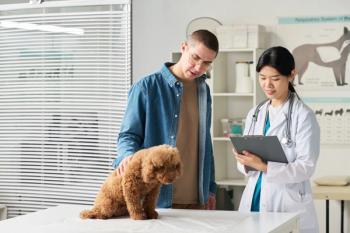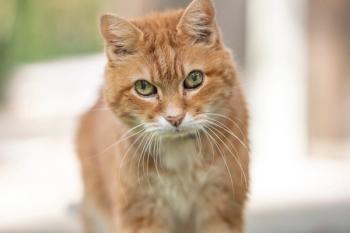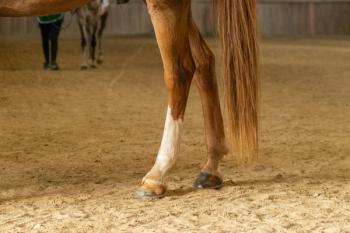
On the Forefront: Looking at canine angular limb deformities in a new way
Angular limb deformities are common orthopedic conditions in dogs, and a wide variety of deformities can occur. These deformities have most commonly been described in the canine antebrachium.
Angular limb deformities are common orthopedic conditions in dogs, and a wide variety of deformities can occur. These deformities have most commonly been described in the canine antebrachium. Variation in angular conformation of other long bones has been speculated to contribute to other orthopedic conditions, including patellar luxation and cranial cruciate ligament rupture.
Until recently, a common vocabulary did not exist within the veterinary lexicon with which to discuss angular deformities of all affected bones. Different systems of describing the quantity and location of deformities were used for different bones. Furthermore, parameters for normal joint angulation and relationships did not exist, making the goals for surgical correction ill-defined.
RESEARCHING LONG BONE ANGULAR RELATIONSHIPS
A number of ongoing research projects at the University of Missouri–Columbia Veterinary Medical Teaching Hospital (umcvmth) are focused on re-examining a variety of orthopedic conditions that specifically relate to the angular relationship of the long bones. Through this research, a vocabulary is being established from references designed for human application to uniformly describe the quantity, direction, and relationship of all long bone deformities in small-animal patients. This classification system, referred to as the Center of Rotation of Angulation (cora) methodology, was developed by Dr. Dror Paley, an orthopedic surgeon.1 The cora methodology necessitates understanding the affected bone's anatomical and mechanical axes and the relationship of these axes to the adjacent joints.1 When a bone is abnormally angulated, so too are the bone's axes. These axial angles can be used to help consistently localize and quantify deformities, whether the bone in question is a radius or a femur.
ANGULAR LIMB DEFORMITY CLASSIFICATIONS
Abnormal bone angulation can be classified based on the number of deformities present, the direction of the deformities, and the relationship of the deformities to one another (Figure 1).2
1. Preoperative and one-year postoperative photographs of an adult male basset hound presented to the University of Missouri-Columbia Veterinary Medical Teaching Hospital for evaluation of bilateral biapical uncompensated (right forelimb) and partially compensated (left forelimb) antebrachial deformities. These deformities, localized and quantified by using the CORA methodology, were repaired with multiple corrective osteotomies.
Bones with single, dual, or three or more deformities can be referred to as uniapical, biapical, and multiapical, respectively.
Directionality of deformity is described in three planes: the frontal plane as determined on cranial-to-caudal radiographs, the sagittal plane as determined on medial-to-lateral radiographs, and rotationally as determined by physical examination and radiography. Orthogonal radiographs that include the joint above and below the affected bone are obtained; oblique radiographs can be taken as necessary, depending on the amount of the rotational deformity present. Deviations toward and away from the midline in the frontal plane are named varus and valgus, respectively. Cranial bowing in the sagittal plane is named procurvatum, and caudal bowing is named recurvatum. Rotation can either be internal or external.
If a bone possesses multiple deformities, then the relationship between them can also be described.2 For example, a proximal varus deformity and a distal valgus deformity are thought of as partially compensated because they occur in opposite directions, thus representing the complementary developmental adaptation of forces on the growth plates. An uncompensated biapical deformity is one in which the deformities occur in the same direction, and, thus, the angulation worsens along the length of the bone. Some early evidence suggests that chondrodystrophic breeds, such as basset hounds, may have a higher incidence of biapical antebrachial deformities than other dogs do (Fox DB, Appel SL. University of Missouri-Columbia Veterinary Medical Teaching Hospital, Columbia, Mo: Unpublished data, 2007).
ESTABLISHING REFERENCE VALUES
A critical part of surgically correcting angular limb deformities of any bone is having a reference for what constitutes normal in that particular patient so that objective goals for surgical correction can be established. If an animal is affected unilaterally, the opposite, unaffected side can be used to obtain measurements of normal anatomical and mechanical axes and their relationship to the associated joints for that patient. However, if a dog is affected bilaterally, reference values should be used. Numerous studies are now being completed at umcvmth to report such reference values in dogs based on breed. For example, the canine radius possesses a normal procurvatum of about 25 degrees and is angled within the antebrachium in the frontal plane by about 2.7 degrees.2 The canine femur is similarly complex in shape, exhibiting a normal distal varus of about 4 to 8 degrees depending on breed.3
THE CORA METHODOLOGY AND SURGICAL CORRECTION
Angular alterations of canine long bones are among the most common orthopedic surgeries performed. Examples include radial-ulnar deformity correction,2 excessive distal femoral varus correction in the treatment of patellar luxation,4 and tibial plateau leveling osteotomy for the treatment of cranial cruciate ligament rupture.5 Each of these surgeries is similar in that the success of the procedures depends on the accuracy of deformity localization, preoperative planning using normal standard references, and correct execution of bone realignment through osteotomies. The cora principles as outlined by Paley and others help to accomplish these tasks by providing a usable vocabulary and repeatable and consistent methodologies of correction.
Through the studies completed and currently under way at UMCVMTH, we hope to optimize angular limb deformity correction outcomes in small-animal patients by fully developing a common vocabulary regardless of the affected bone, more accurately defining the common types of angular deformities seen in dogs and cats, and demonstrating the utility and effect of the various osteotomies used for long bone correction.
The information for "On the Forefront" was provided by Derek B. Fox, DVM, PhD, DACVS, Department of Veterinary Medicine and Surgery, College of Veterinary Medicine, University of Missouri, Columbia, MO 65211.
REFERENCES
1. Paley D. Principles of deformity correction. Berlin: Springer-Verlagg, 2002.
2. Fox DB, Tomlinson JL, Cook JL, et al. Principles of uniapical and biapical radial deformity correction using dome osteotomies and the center of rotation of angulation methodology in dogs. Vet Surg 2006;35:67-77.
3. Tomlinson JL. Tibial and femoral angles in normal dogs, in Proceedings. Am Coll Vet Surg Vet Symp 2006;390-391.
4. Peruski AM, Kowaleski MP, Pozzi, et al. Treatment of medial patellar luxation and distal femoral varus by femoral wedge osteotomy in dogs: 30 cases (2000-2005), in Proceedings. 33rd Annu Vet Orthop Soc Meet, Keystone 2006;240.
5. Slocum B, Slocum TD. Tibial plateau leveling osteotomy for cranial cruciate ligament rupture. In Bojrab MJ, ed. Current techniques in small animal surgery. 4th ed. Baltimore, Md: Williams & Wilkins, 1998;1209-1215.
Newsletter
From exam room tips to practice management insights, get trusted veterinary news delivered straight to your inbox—subscribe to dvm360.





